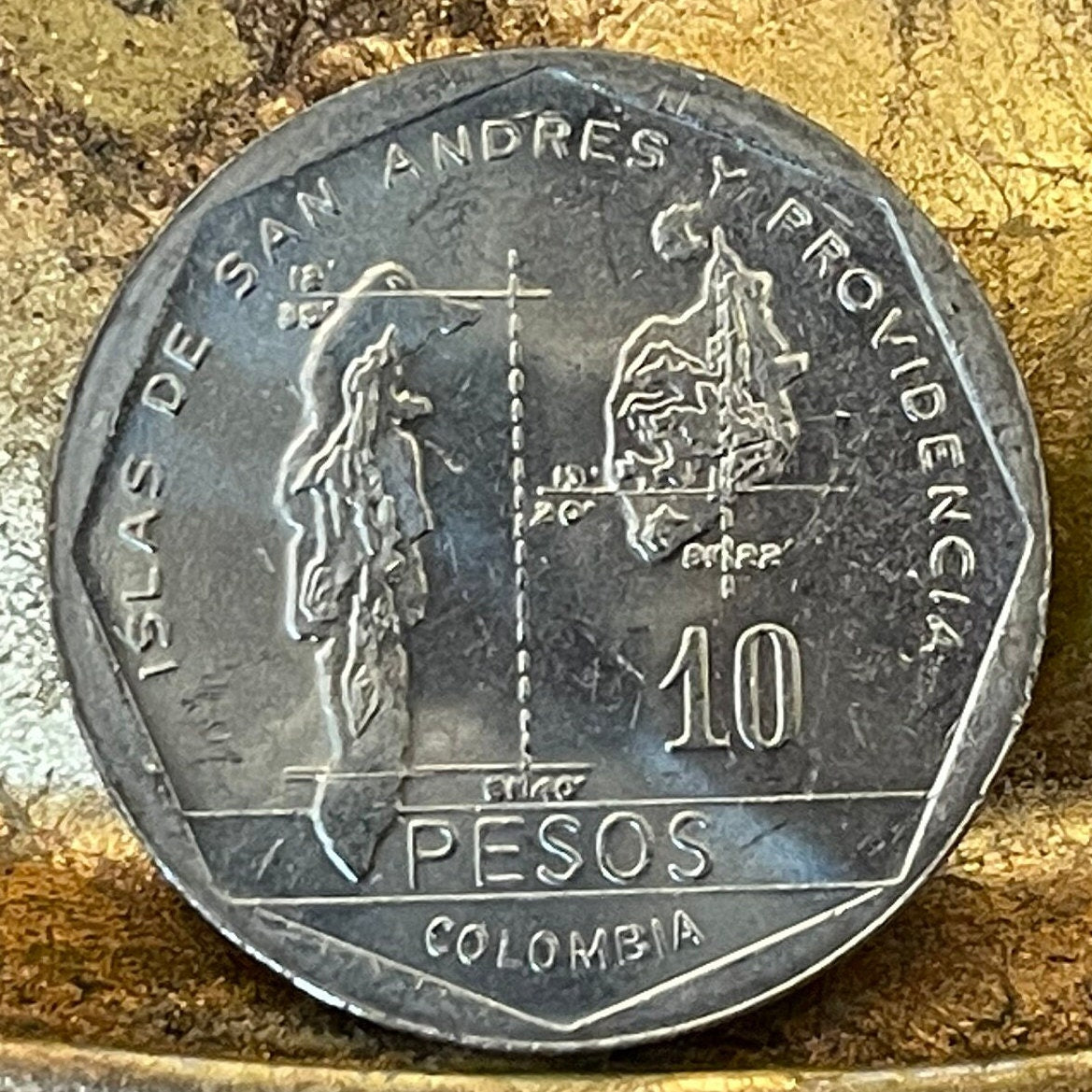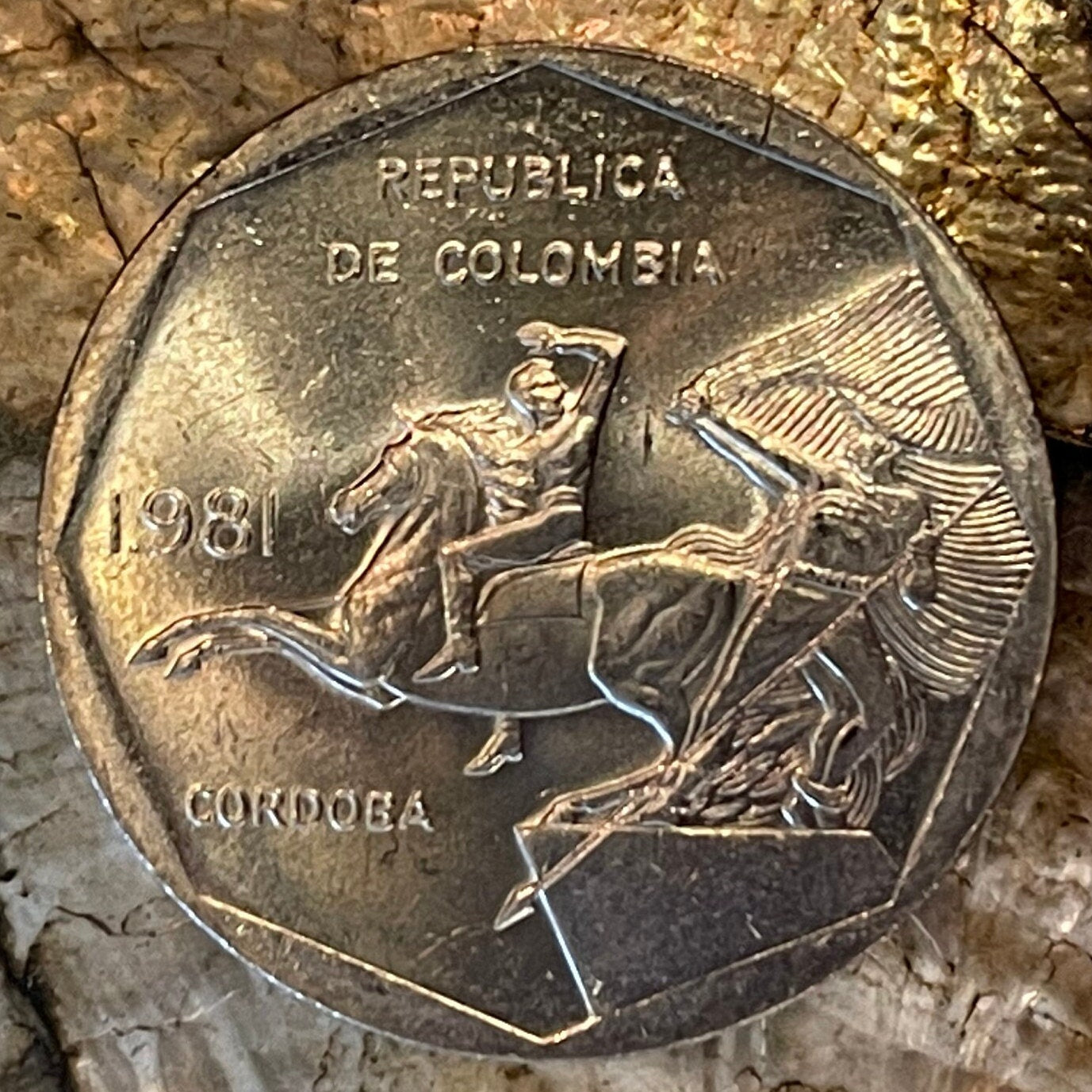elemintalshop
José María Córdova Statue by Betancourt & Archipelago of San Andres and Providencia 10 Pesos Colombia Authentic Coin Money for Jewelry
José María Córdova Statue by Betancourt & Archipelago of San Andres and Providencia 10 Pesos Colombia Authentic Coin Money for Jewelry
Couldn't load pickup availability
José María Córdova Statue by Rodrigo Arenas Betancourt & Archipelago of San Andres and Providencia 10 Pesos Colombia Authentic Coin Money for Jewelry and Craft Making (Horseback Warrior)
Obverse: Monument by Rodrigo Arenas Betancourt, "Tribute to José Maria Córdoba" -- located in Principal Park, Rionegro (Antioquia) -- within an octagonal rim
Lettering: REPUBLICA DE COLOMBIA
CORDOBA
Translation: Republic of Colombia
Cordoba
Reverse
Map of the San Andrés and Providencia Islands, Colombian archipelago located about 700 km northwest of Colombia, in the Caribbean Sea, off Nicaragua. 13°20'N 81°22'O are the coordinates of Providencia Island. 81°40'O is the coral reef longitude, east of Saint Andrés.
Lettering: ISLAS DE SAN ANDRES Y PROVIDENCIA
13°20 81°22
81°40
10 PESOS COLOMBIA
Translation: San Andres and Providencia Islands
13 ° 20 81 ° 22
81 ° 40
10 Pesos Colombia
Features
Issuer Colombia
Period Republic (1886-date)
Type Standard circulation coin
Years 1981-1989
Value 10 Pesos
10 COP = USD 0.0027
Currency Peso decimalized (1847-date)
Composition Nickel brass
Weight 9.96 g
Diameter 28 mm
Thickness 1.75 mm
Shape Round
Technique Milled
Orientation Coin alignment ↑↓
Number N# 2435
References KM# 270
Wikipedia:
José María Córdova Muñoz, also known as the "Hero of Ayacucho", was a General of the Colombian army during the Independence War of Colombia, Perú, and Bolivia from Spain.
*******
Wikipedia:
Rodrigo Arenas Betancourt (El Uvital, rural area of Fredonia ( Antioquia ), October 23, 1919 - Medellín , May 14, 1995) was a Colombian sculptor and writer. He is considered one of the most prolific and appreciated Colombian artists nationally and internationally. His works are characterized by being gigantic, melodramatic and spectacular, highlighting in many of them the great characters of Colombian history as well as their important deeds and works. Many of his sculptures are public monuments, almost all of his work being found in different cities of Colombia and Mexico.. Some works that were not conceived to be exhibited in public remain in Caldas (Antioquia) under the care of his wife, María Elena Quintero de Arenas, and their five children. He was a serial sculptor who always worked with bronze, concrete, and steel, although some of his early work also included terracotta. He won the National Prize for Plastic Arts of Colombia in 1975, awarded by Colcultura.
*******
Wikipedia:
The Archipelago of San Andrés, Providencia and Santa Catalina (Spanish: Archipiélago de San Andrés, Providencia y Santa Catalina, or, in everyday language, San Andrés and Providencia, is one of the departments of Colombia. It consists of two island groups in the Caribbean Sea about 775 km (482 mi) northwest of mainland Colombia, and eight outlying banks and reefs. The largest island of the archipelago is called San Andrés and its capital is San Andrés. The other large islands are Providencia and Santa Catalina Islands which lie to the north-east of San Andrés; their capital is Santa Isabel.
History
Spain formally claimed the archipelago of San Andres and Providencia in 1510, a few years after the voyages of Christopher Columbus. In 1544, the territory was placed under the administration of the Captaincy General of Guatemala. During the early years, Spain concentrated on exploring and colonizing the mainland and hardly settled the islands.
In 1630, English Puritans arrived in Providence Island, under the aegis of the Providence Island Company. The Puritans decided to settle the tropical islands, rather than cold, rocky New England, but the Providence Island colony did not succeed in the same way as the Massachusetts Bay Colony. They established slave-worked plantations and engaged in privateering, which led to the Spanish and Portuguese conquering the colony in May, 1641. In 1670, English buccaneers, led by Henry Morgan, took over the islands, which he used as a base to attack Panama. The buccaneers abandoned the islands by 1672. There is no record of anyone inhabiting the islands from then for another century.
In 1775, Lieutenant Tomás O'Neil, a Spaniard of Irish descent, was given military command of the islands and, in 1790, was named governor. He requested the transfer of the islands to the jurisdiction of the Viceroyalty of New Granada, which was granted in 1803. That year, Spain assigned the islands, together with the province of Veraguas (western Panama and the east coast of Nicaragua), to the Viceroyalty of New Granada. The territory was administered from the province of Cartagena. Soon, trade links with Cartagena were greater than those with Guatemala.
On 4 July 1818, a French corsair, Louis-Michel Aury, with 400 men and 14 ships flying the Argentine flag, captured Old Providence and St. Catherine islands. The island was populated by white English-speaking Protestants and their slaves. Aury and his team used the islands as their new base from which to pursue Central American independence. However, his efforts to also support Bolivar in his fight for Venezuelan and Colombian independence were repeatedly turned down.
After the Spanish colonies became independent, the inhabitants of San Andrés, Providence and St. Catherine voluntarily adhered to the Republic of Gran Colombia in 1822, which placed them under the administration of the Magdalena Department. The First Mexican Empire, which was succeeded by the United Provinces of Central America (UPCA), also claimed the islands. Gran Colombia, in turn, protested the UPCA's occupation of the eastern coast of Nicaragua. The UPCA broke up in 1838 to 1840, but Nicaragua carried on the dispute, as did Gran Colombia's successors: New Granada and Colombia. A local administration (intendencia) was established in the islands in 1912 by Colombia.
In 1928, Colombia and Nicaragua signed the Esguerra-Bárcenas Treaty, which gave control of the islands to Colombia. However, when the Sandinista government assumed power in the 1980s, Nicaragua repudiated the treaty. Colombia argues that the treaty's final ratification in 1930 (when the US forces were already on their way out) confirms its validity. Colombia and Honduras signed a maritime boundary treaty in 1999, which implicitly accepts Colombian sovereignty over the islands.
In 2001, Nicaragua filed claims with the International Court of Justice (ICJ) over the disputed maritime boundary and claimed 50,000 km2 (19,305 sq mi) in the Caribbean, including the San Andrés and Providencia Archipelagoes. Colombia responded that the court has no jurisdiction over the matter and increased its naval and police presence in the islands. Colombia also defended its claim in the ICJ. On 13 December 2007, the ICJ ruled that the islands were Colombian territory but left the maritime border dispute unresolved. On 19 November 2012, the ICJ held that Colombia had sovereignty over the islands.
Share



















